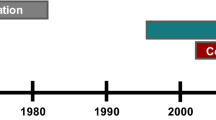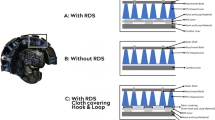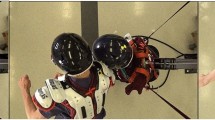Abstract
Helmets and shoulder pads are required equipment intended to protect American football athletes by attenuating collision forces during participation. Surprisingly, research differentiating kinematics from head impacts initiated by helmets from those initiated by shoulder pads among adolescent athletes has not been completed. The current study’s purpose was to determine the effects of equipment on head impact kinematics. Sixty-nine male American football athletes from three high schools wore helmets equipped with Head Impact Telemetry (HIT) System instrumentation to quantify peak linear (g) and rotational (rad/s2) accelerations. Data were extracted for video-confirmed impacts during two competitions. Separate multivariable linear regressions using ordinary least squares were conducted to determine if equipment type (helmet vs. shoulder pad) was associated with log-transformed linear and rotational accelerations. In total, 1150 video-confirmed impacts involved helmet (N = 960) or shoulder pad (N = 190) initiated contact. Linear (p = 0.809) and rotational (p = 0.351) acceleration were not associated with equipment type. Head impact kinematics were similar between impacts initiated by either helmets or shoulder pads and suggests an opponent’s shoulder pads and helmet can deliver comparable forces to the struck player. Equipment manufacturers may need to consider the unintended role shoulder pads may contribute to head injury risk.

Similar content being viewed by others
References
Bryan, M. A., et al. Sports- and recreation-related concussions in US Youth. Pediatrics. 138(1):8, 2016.
Halstead, M. E., et al. Sport-related concussion in children and adolescents. Pediatrics.142(6):e20183074, 2018.
Daniel, R. W., S. Rowson, and S. M. Duma. Head impact exposure in youth football. Annals of biomedical engineering. 40(4):976–981, 2012.
Baillargeon, A., et al. Neuropsychological and neurophysiological assessment of sport concussion in children, adolescents and adults. Brain injury. 26(3):211–220, 2012.
Schmidt, J. D., et al. Age at first concussion influences the number of subsequent concussions. Pediatric neurology. 81:19–24, 2018.
Lessley, D. J., et al. Video analysis of reported concussion events in the National Football League during the 2015–2016 and 2016–2017 seasons. The American journal of sports medicine. 46(14):3502–3510, 2018.
Rowson, B., and S. M. Duma. A Review of On-Field Investigations into the Biomechanics of Concussion in Football and Translation to Head Injury Mitigation Strategies. Ann Biomed Eng. 48(12):2734–2750, 2020.
Wusk, Z., and S. Rowson. Football Shoulder Pad Design and Its Effect on Head Kinematics in Shoulder-to-Helmet Impacts. Ann Biomed Eng. 50(11):1444–1451, 2022.
Broglio, S. P., et al. Cumulative Head Impact Burden in High School Football. Journal of Neurotrauma. 28(10):2069–2078, 2011.
Cecchi, N. J., et al. Identifying Factors Associated with Head Impact Kinematics and Brain Strain in High School American Football via Instrumented Mouthguards. Ann Biomed Eng. 49:2814–2826, 2021.
Martini, D., et al. Subconcussive head impact biomechanics: comparing differing offensive schemes. Med Sci Sports Exerc. 45(4):755–761, 2013.
Schmidt, J. D., et al. Head Impact Magnitude in American High School Football. Pediatrics. 138(2):789, 2016.
Ocwieja, K. E., et al. The Effect of Play Type and Collision Closing Distance on Head Impact Biomechanics. Annals of Biomedical Engineering. 40(1):90–96, 2012.
Broglio, S. P., et al. Head impacts during high school football: a biomechanical assessment. J Athl Train. 44(4):342–349, 2009.
Jadischke, R., et al. On the accuracy of the Head Impact Telemetry (HIT) System used in football helmets. Journal of biomechanics. 46:2310–2315, 2013.
Arbogast, K. B., et al. Consensus Head Acceleration Measurement Practices (CHAMP): Origins, Methods, Transparency and Disclosure. Annals of Biomedical Engineering. 50(11):1317–1345, 2022.
Mihalik, J. P., et al. Collision type and player anticipation affect head impact severity among youth ice hockey players. Pediatrics. 125(6):e1394–e1401, 2010.
Le, R. K., et al. On-field Characteristics and Head Impact Magnitude in Youth Tackle Football. Pediatric Neurology. 121:33–39, 2021.
Schmidt, J. D., et al. Head Impact Magnitude in American High School Football. Pediatrics.138(2):e20154231, 2016.
Kerr, Z. Y., et al. Impact locations and concussion outcomes in high school football player-to-player collisions. Pediatrics. 134(3):489–496, 2014.
Kerr, Z. Y., et al. Concussion Incidence and Trends in 20 High School Sports. Pediatrics. 144:5, 2019.
Rowson, S., et al. Rotational head kinematics in football impacts: an injury risk function for concussion. Ann Biomed Eng. 40(1):1–13, 2012.
Ocwieja, K. E., et al. The effect of play type and collision closing distance on head impact biomechanics. Ann Biomed Eng. 40(1):90–96, 2012.
Mihalik, J. P., et al. Measurement of head impacts in collegiate football players: an investigation of positional and event-type differences. Neurosurgery. 61(6):1229–1235, 2007. (discussion 1235)
Wiebe, D. J., et al. Association between the experimental kickoff rule and concussion rates in Ivy League football. Jama. 320(19):2035–2036, 2018.
Broglio, S. P., T. Surma, and J. A. Ashton-Miller. High School and Collegiate Football Athlete Concussions: A Biomechanical Review. Annals of Biomedical Engineering. 40(1):37–46, 2012.
Daneshvar, D. H., et al. Helmets and mouth guards: the role of personal equipment in preventing sport-related concussions. Clinics in sports medicine. 30(1):145–163, 2011.
Caplar, N., S. Tacchella, and S. Birrer. Quantitative evaluation of gender bias in astronomical publications from citation counts. Nat. Astron. 1(6):1–5, 2017.
Dion, M. L., J. L. Sumner, and S. M. Mitchell. Gendered citation patterns across political science and social science methodology fields. Polit. Anal. 26(3):312–327, 2018.
Dworkin, J. D., et al. The extent and drivers of gender imbalance in neuroscience reference lists. Nat. Neurosci. 23(8):918–926, 2020.
Maliniak, D., R. Powers, and B. F. Walter. The gender citation gap in international relations. Int. Organ. 67(4):889–922, 2013.
Mitchell, S. M., S. Lange, and H. Brus. Gendered citation patterns in international relations journals. Int. Stud. Perspect. 14(4):485–492, 2013.
Acknowledgements
We would like to thank Kody Campbell and Joshua Boone for their contributions to data collection.
Citation diversity statement
Recent work in several fields of science has identified a bias in citation practices such that papers from women and other minority scholars are under cited relative to the number of papers in the field. [28,29,30,31,32] We recognize this bias and have worked diligently to ensure that we are referencing appropriate papers with fair gender and racial author inclusion.
Funding
The work described in this manuscript was supported by a grant awarded by the National Operating Committee on Standards for Athletic Equipment (NOCSAE®) to the Datalys Center for Sports Injury Research and Prevention under Grant RFP 01-2021. The raw video data analyzed in this study were originally collected in a project funded by the National Center for Injury Prevention and Control (Centers for Disease Control and Prevention) through the Injury Prevention Research Center at the University of North Carolina at Chapel Hill (2R49CE002479). The authors disclose receipt of grants and research support awarded to their institution from the Department of Defense, the National Collegiate Athletic Association, and the National Football League unrelated to the current project.
Author information
Authors and Affiliations
Corresponding author
Ethics declarations
Conflicts of interest
Dr. Jason Mihalik is a co-founder and Chief Science Officer for Senaptec, Inc., but neither data nor instrumentation from this entity are included in the current manuscript. The remaining authors report there are no competing interests to declare.
Additional information
Associate Editor Steven Rowson oversaw the review of this article.
Publisher's Note
Springer Nature remains neutral with regard to jurisdictional claims in published maps and institutional affiliations.
Supplementary Information
Below is the link to the electronic supplementary material.
Rights and permissions
Springer Nature or its licensor (e.g. a society or other partner) holds exclusive rights to this article under a publishing agreement with the author(s) or other rightsholder(s); author self-archiving of the accepted manuscript version of this article is solely governed by the terms of such publishing agreement and applicable law.
About this article
Cite this article
Sinnott, A.M., Collins, C.L., Boltz, A.J. et al. Comparison of Kinematics for Head Impacts Initiated by Helmets and Shoulder Pads Among High School American Football Athletes. Ann Biomed Eng (2024). https://doi.org/10.1007/s10439-024-03485-1
Received:
Accepted:
Published:
DOI: https://doi.org/10.1007/s10439-024-03485-1




